



"How did our universe begin, and how did it evolve into what we see today?" This has been one of humanity's most profound questions since ancient times. Cosmology and astrophysics explore these mysteries through the lens of physics. The theory proposed by George Gamow in 1948 laid the foundation for modern cosmology and has since been supported by a wealth of observational evidence from the 20th and 21st centuries. According to this theory, the universe began in an extremely hot and dense state—the Big Bang—approximately 13.8 billion years ago and has been expanding ever since.
The Big Bang theory predicts that the early universe consisted almost entirely of hydrogen, helium, and a trace of lithium, with no heavier elements. Yet, about 2% of the solar system's mass comprises heavier elements, and our bodies are made of elements like carbon, calcium, iron, phosphorus, and chlorine. Recent observations have revealed the presence of heavy elements even in the early universe. This raises key questions: When, where, and how were these elements formed and dispersed? Furthermore, how and when did life emerge in this evolving universe?
Following the Big Bang, dark matter—believed to constitute most of the universe's mass—permeated the cosmos. While essential for explaining the formation of galaxies and the universe's large-scale structure, dark matter remains undetected in particle physics experiments. In the early universe, gravitational instabilities amplified the density fluctuations in dark matter. Baryonic matter followed, accumulating in these dark matter potential wells, where stars and galaxies began to form. As stars evolved and exploded as supernovae, they synthesised new elements and distributed them into the interstellar medium, enriching the universe.
Galaxies continued to evolve through mergers and interactions. For instance, massive galaxies like the Milky Way and Andromeda formed through successive mergers of smaller galaxies over billions of years. The solar system emerged in the Milky Way approximately 4 billion years ago, ultimately giving rise to life on Earth. In a few billion years, the Milky Way and Andromeda are predicted to merge into a giant elliptical galaxy. Such collisions not only trigger star formation by violently stirring interstellar matter but also influence the activity of supermassive black holes at galactic centers.
Our aim in developing the Standard Model of Galaxy Formation and Evolution is to unravel the processes behind galaxy assembly, the creation and distribution of elements, black hole dynamics, and the nature of dark matter. Our research group is dedicated to scientifically tracing the evolution of galaxies and the universe while contemplating its future.
Below are highlights of our research themes and activities, including a study featured in Nature on the connection between galaxy evolution and Lyman-alpha emitters, another from Nature Astronomy examining black hole activity induced by galactic collisions, and continuing efforts to understand the Andromeda galaxy — a topic that has gradually become a central focus of our group.
Cusp-Core Problem:
Studies of dark matter halo mass distributions suggest a universal cusp-like structure, where
density rises steeply toward the centre. However, precise measurements of rotation curves in
nearby dwarf galaxies often reveal a flatter, nearly constant density distribution at the
centre—a core-like structure that contradicts theoretical predictions. This mismatch between
simulations and observations is known as the "Cusp-Core Problem." A related issue, the
"Too-Big-to-Fail Problem," refers to the puzzling absence of massive satellite galaxies with
dense dark matter cores, as predicted by simulations. While galaxy formation simulations have
phenomenologically demonstrated that feedback from supernovae can flatten central density
profiles by modifying the gravitational potential, the fundamental physical processes underlying
this cusp-to-core transition remain poorly understood.
Missing Satellite Problem:
Cosmological N-body simulations based on hierarchical structure formation theory predict that
galaxies like the Milky Way and Andromeda should host hundreds or even thousands of dark matter
subhalos. Yet only about 50 satellite galaxies have been observed in each system. This large
discrepancy, known as the "Missing Satellite Problem," poses a significant challenge to the cold
dark matter (CDM) model. One proposed resolution is that many of these subhalos are dark
satellites—halos that did not form stars and thus remain undetectable by conventional means.
However, the existence of such objects and effective methods to identify them remain open areas
of investigation.
These problems are essential to understanding the fundamental nature of dark matter. They are closely linked to astrophysical processes such as star formation and supernova feedback within dark matter-dominated environments. To address these challenges, our research focuses on the detailed co-evolution of galaxies and dark matter halos. Using comprehensive models that incorporate optical, chemical, and dynamical evolution, we aim to confront the limitations of the CDM model, particularly in relation to the Cusp-Core and Missing Satellite Problems.
Dark matter halos surrounding galaxies exhibit well-defined correlations among various observable quantities, commonly referred to as "scaling relations." Yet, the physical origins of these relations remain elusive and demand further theoretical and observational investigation. In our study, we used the correlation between halo concentration and mass (the c–M relation), derived from cosmological N-body simulations under the Cold Dark Matter (CDM) paradigm, to establish theoretical scaling relations involving surface mass density, maximum rotation velocity, and scale radius. By comparing these predictions with observational data across a wide mass range, we demonstrated that the scaling relations observed in both low-mass and high-mass galaxies can be traced back to the c–M relation. Our models further predict that these relations extend to the scale of galaxy clusters.
We also proposed a new scaling relation that incorporates the so-called "cusp-to-core transition" expected to occur in CDM halos. In this context, a cusp refers to a steep density profile near the halo center, while a core denotes a flattened distribution. This transformation is believed to be triggered by baryonic processes such as supernova feedback, which redistribute dark matter in the inner halo regions. We explore the feasibility of observationally validating this transition. Recent advances in observation and simulation techniques offer promising avenues for testing the cusp-core transformation and enhancing our understanding of dark matter and galaxy formation.
In this presentation at the KASHIWA DARK MATTER SYMPOSIUM 2021, held at the University of Tokyo from November 29 to December 2, 2021, first-year master's student Yuka Kaneda (as of December 2021) presented her work on the dynamical evolution of dark matter halos. Her research was recognized with the Best Poster Award, selected by participant vote.
The standard model of galaxy formation, based on hierarchical structure formation in a CDM universe, predicts that galaxies are embedded in dark matter halos with more than twice the mass of their stellar components. However, recent discoveries have reported the existence of dark matter-deficient galaxies whose halo masses are significantly lower than predicted. To address this serious challenge, we investigated a new galaxy formation scenario driven by head-on collisions between dark matter subhalos containing primordial gas.
Our analytic estimates revealed that within 10% of a host halo’s virial radius, such subhalo collisions occur frequently, with characteristic timescales on the order of 10 million years. We also found that the relative velocity of subhalos increases with distance from the halo center. Using a combination of analytical modeling and N-body/hydrodynamic simulations, we demonstrated that the outcome of a collision—whether it results in a dark matter-rich or -deficient galaxy—depends strongly on the relative velocity. At low velocities, merging subhalos form a galaxy rich in dark matter. At moderate velocities, the gas components collide even as the dark matter passes through, leading to local gas compression and intense star formation. This results in the formation of a dark matter-deficient galaxy at the collision interface. At high velocities, however, the shockwave breaks out from the gas surface and disperses the gas before it can collapse, preventing galaxy formation altogether.
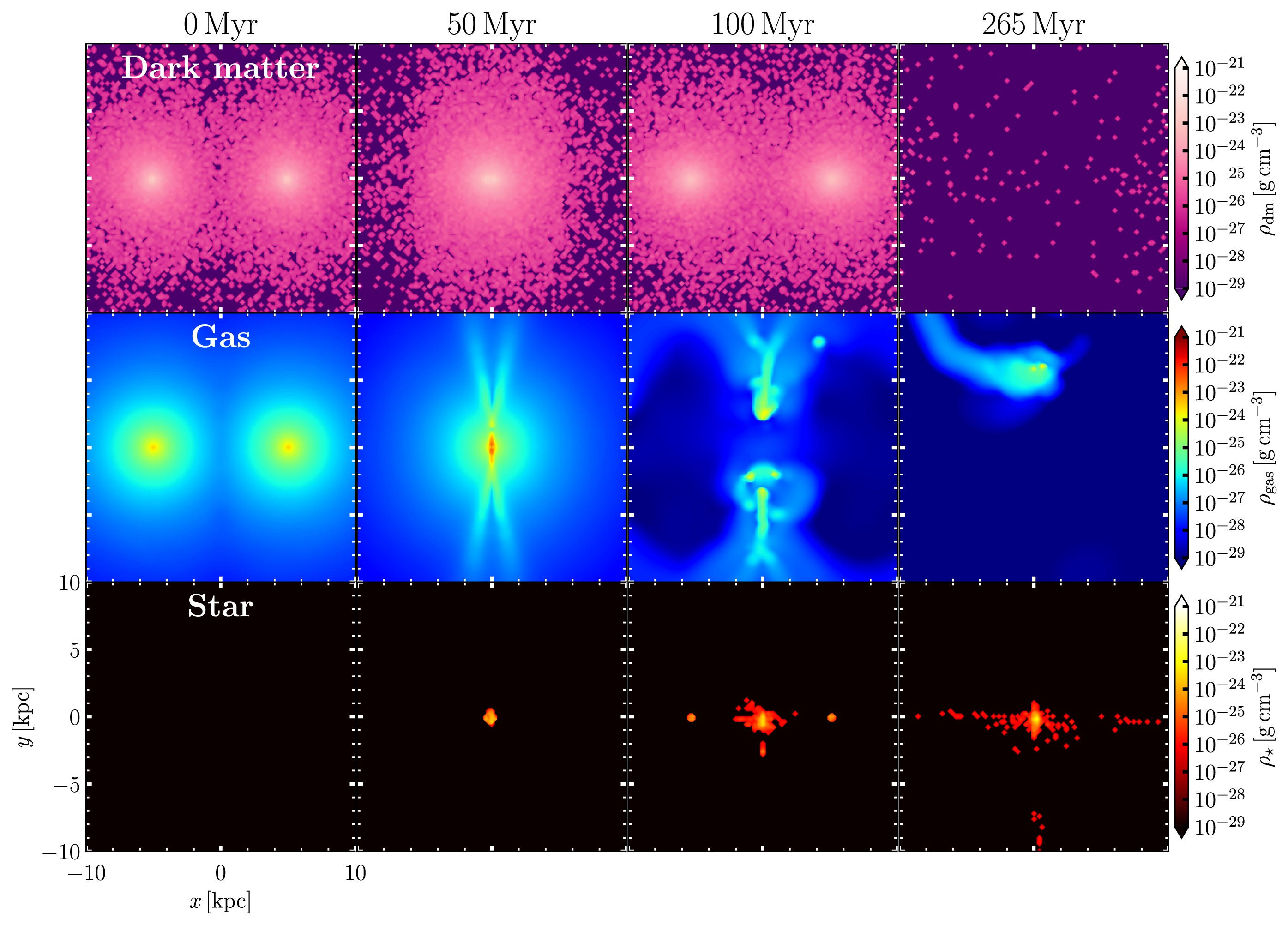
Adapted from Otaki & Mori, Monthly Notices of the Royal Astronomical Society, 25, 2535 (2023)
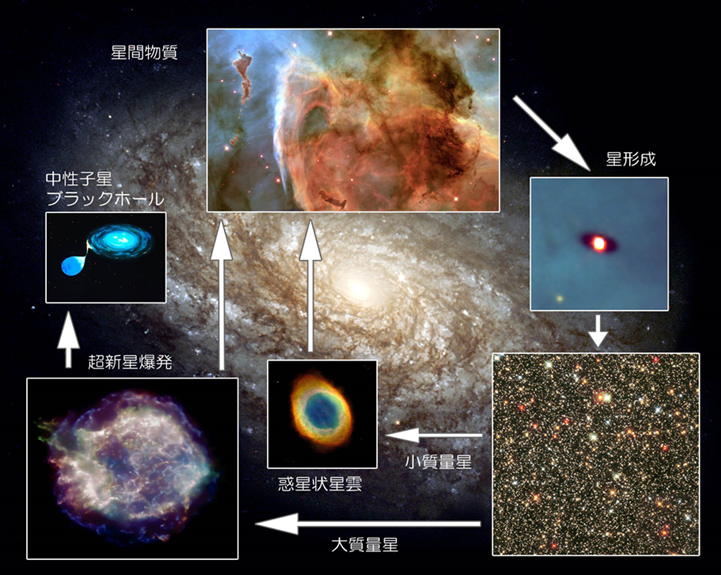
Following the Big Bang, the first stars emerged from primordial gas composed solely of hydrogen and helium. Among them, relatively massive stars concluded their lifespans as supernovae. These explosive events expelled elements produced within the stars and during the explosions into interstellar space, mixing with the surrounding medium. Subsequent generations of stars formed from this enriched gas, which now contained trace amounts of heavy elements. When these stars, in turn, ended as supernovae, they released newly synthesized elements into the interstellar medium. Through this cosmic recycling process, the abundance of heavy elements in galaxies gradually increased over time.
The figure below shows the results of a galaxy formation simulation by Mori & Umemura (2006). After approximately 100 million years (leftmost panel), star formation began within the primordial galaxy. Massive stars underwent supernova explosions, stirring the surrounding gas and producing numerous bubble-like structures. Heavy elements from the explosions accumulated in the low-density interiors of these bubbles, while the high-density shells surrounding them remained relatively unenriched, as they were composed of swept-up primordial gas lacking metals. In these early stages of galactic evolution, supernovae were still too infrequent to enrich the entire interstellar medium uniformly, leading to chemically inhomogeneous conditions.
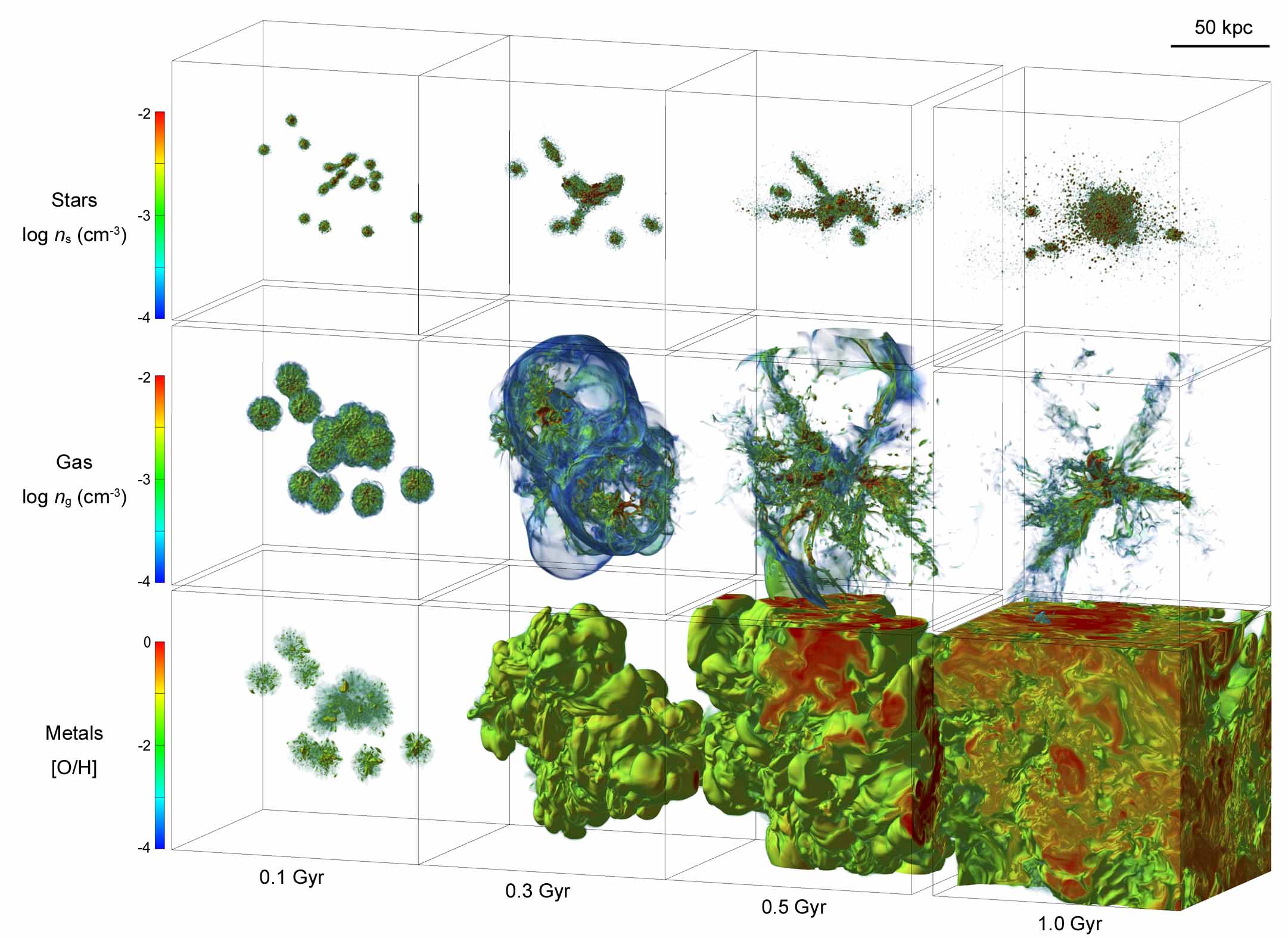
Simulation results: each row shows, from top to bottom, the distributions of stars, gas, and heavy elements (oxygen). The panels represent time evolution from left to right: 100 million, 300 million, 500 million, and 1 billion years. (Adapted from Mori & Umemura, Nature, 440, 644 (2006))
(Top) Simulation snapshots. The top, middle, and bottom rows represent the density distributions of stars, gas, and heavy elements (oxygen), respectively. Each column corresponds to a different evolutionary stage: 100 million, 300 million, 500 million, and 1 billion years. (Bottom) Evolution of gas density: repeated supernova explosions produce complex structures, including dense gas shells and filaments. (See Mori & Umemura, Nature, 440, 644 (2006))
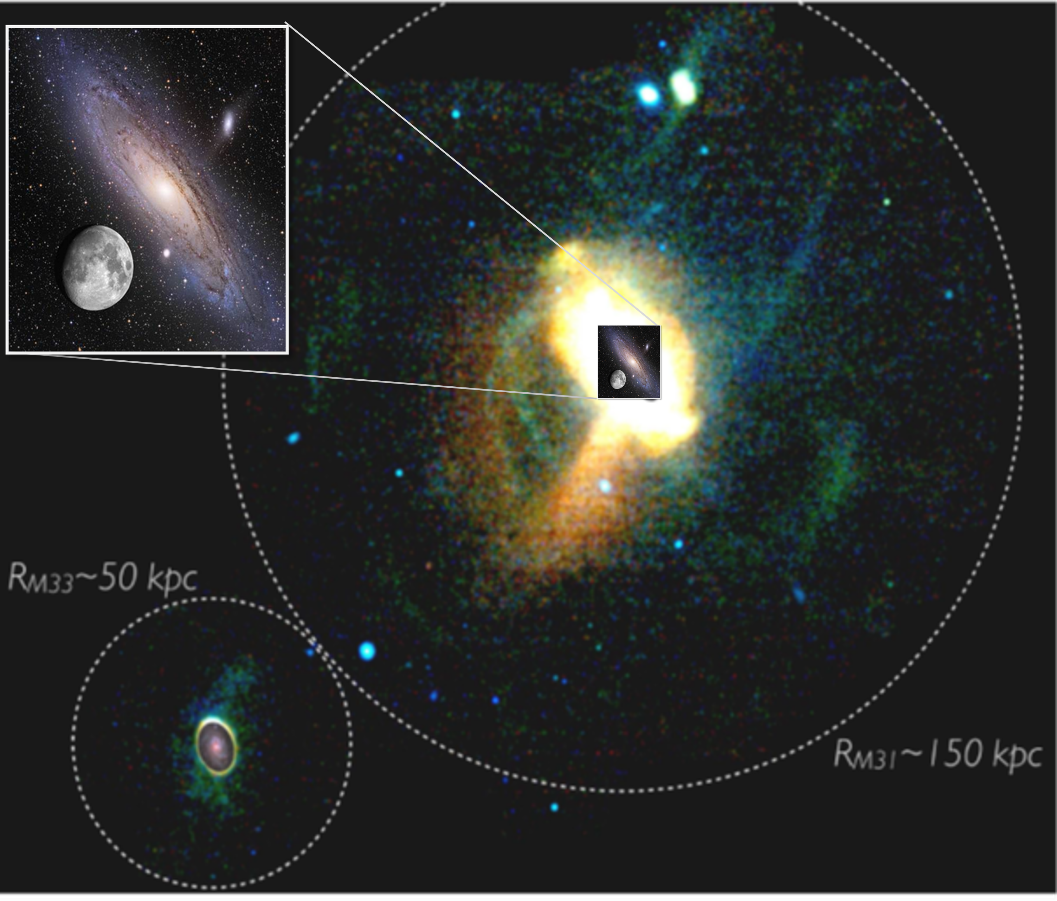
Large-scale structures surrounding the Andromeda Galaxy revealed by the Pan-Andromeda Archaeological Survey. The central elongated stellar feature, known as the Andromeda Giant Stream, extends approximately 450,000 light-years and contains more than 10 million solar masses. (Adapted from McConnachie et al., Nature, 461, 66 (2009))
Observations have revealed an intricate network of faint stellar structures around Andromeda, including shells and streams composed of extremely low-density stars. The inclusion of the Moon in the figure offers a sense of scale, underscoring how the visible structure of galaxies represents only a small portion of their full extent.
Using high-resolution simulations on supercomputers, we demonstrated that these features were produced by the tidal disruption of a small galaxy—approximately 1/400 the mass of Andromeda—that was captured by Andromeda’s gravity about 1 billion years ago. The remnants of this galaxy now form the Andromeda Giant Stream and a series of overlapping stellar shells, providing compelling evidence for the transformative role of galactic collisions in galaxy evolution.
This finding confirms that galaxy mergers, a cornerstone of hierarchical structure formation theory, continue to shape even massive, mature galaxies like Andromeda. Ongoing and future high-precision observations, supported by state-of-the-art instruments, will further uncover these structures. Our theoretical work contributes to this global effort to understand galactic history.
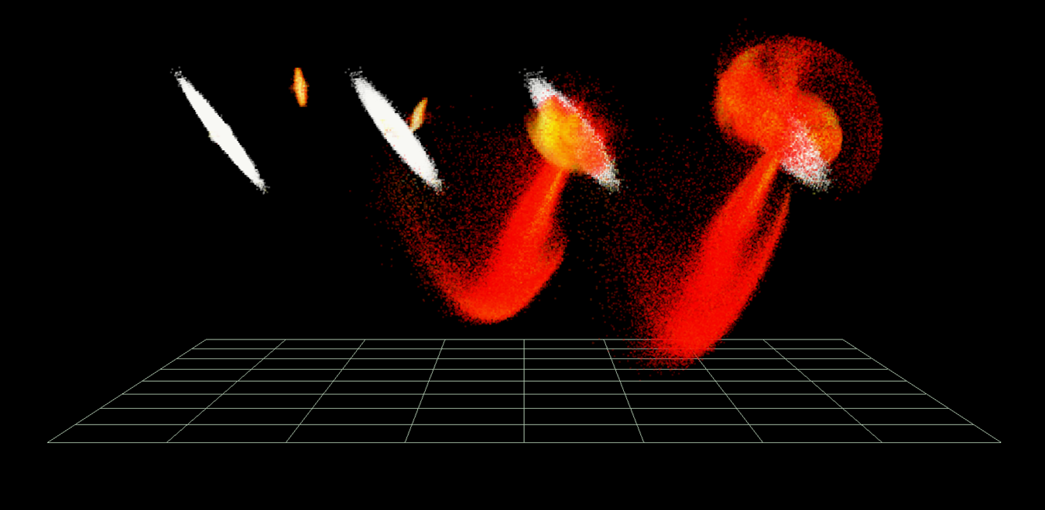
Simulation of a collision involving a dwarf disc galaxy. The white structure represents Andromeda; the yellow-red points show the dwarf galaxy, which is disrupted by tidal forces during the encounter. (Adapted from Kirihara, Miki, Mori, Kawaguchi & Rich, MNRAS, 469, 3390 (2017))
Simulation of a collision between the Andromeda Galaxy and a dwarf satellite. The extended blue structure represents Andromeda. (Mori & Rich, ApJ, 674, L77, 2008)

When large amounts of gas accrete onto a supermassive black hole (SMBH) at the center of a galaxy, the infalling matter releases enormous gravitational energy, igniting the black hole as an active galactic nucleus (AGN). However, gas inflow is often hindered by angular momentum, leading to the formation of a torus-like structure that acts as a reservoir. Galaxy mergers are thought to drive gas toward the galactic center, triggering AGN activity. Yet, the mechanisms responsible for turning off such activity remain elusive.
Despite the universe’s 13.8-billion-year age, SMBHs shine as AGNs for only a brief period—typically around 100 million years. This suggests that most SMBHs, including those at the centers of the Milky Way and Andromeda, are currently dormant due to insufficient gas supply. Recent discoveries of galaxies exhibiting rapid AGN fading have intensified interest in identifying the physical processes responsible for this shutdown.
Miki, Mori & Kawaguchi, Nature Astronomy, 5, 478 (2021)
Building on this model, we extended our investigation to other galaxies and found that the column densities of torus gas surrounding many SMBHs fall within a range that could be stripped during galaxy collisions. This suggests that such collisions may play a key role in terminating AGN activity across the universe. To evaluate the frequency of these events, we conducted high-precision orbital analyses of satellite galaxies using data from the Gaia mission. Our results indicate that major collisions capable of disrupting the torus occur approximately once every 100 million years—coinciding with the typical lifetime of AGN activity. These findings mark a significant advance in understanding the link between galaxy interactions and the life cycle of central black holes.
The concept of the Galactic Habitable Zone (GHZ) was first introduced by Gonzalez et al. (2001). It defines regions within the Galaxy where conditions are conducive to the emergence and maintenance of life. Early models suggested that only limited regions of the Milky Way meet these conditions, based on factors such as the abundance of heavy elements, the frequency of supernovae, and the orbital stability of planetary systems. Particular attention has been given to intermediate zones where metallicity supports planet formation and the environment remains stable enough for biological evolution.
Since then, GHZ studies have evolved from static models to dynamic frameworks accounting for secular and spatial changes due to galactic evolution. Research focusing on chemical composition has become central to evaluating the spatiotemporal distribution of bioessential elements. Lineweaver et al. (2004), for instance, demonstrated a correlation between iron abundance and the probability of planet formation, quantitatively assessing the impact of chemical evolution on GHZ development. Recent studies have extended the focus to key elements such as oxygen, carbon, nitrogen, and phosphorus, all of which critically influence the extent and structure of the GHZ.
Against this background, our research investigates the GHZ not only within the Milky Way but across galaxies from a cosmological perspective. We analyze chemical and dynamical evolution to track spatiotemporal fluctuations in star formation, gas flows, and heavy element synthesis. By evaluating the roles of essential elements, we aim to construct a predictive and realistic model of galactic habitability. In collaboration with galaxy formation simulations, we are working toward a unified understanding of GHZ evolution across a variety of galactic environments.
In order to understand our universe scientifically, we must study phenomena across vast spatial and secular scales. For this reason, we have made computational science a central pillar of our research. Our efforts include the development of high-accuracy hydrodynamic schemes, optimization of high-performance computing using GPUs, and applications of machine learning to astrophysical problems. Specifically, we design density-independent SPH schemes based on Godunov-type methods, pursue strong scaling and memory optimization on multi-node GPU systems, and apply supervised and generative learning techniques to bridge observational datasets and numerical experiments. These approaches aim to extract hidden physical processes and enhance the predictive power of future astronomical observations.
Smoothed Particle Hydrodynamics (SPH) was independently proposed in the late 1970s within the field of astrophysics. It rapidly evolved into a Lagrangian numerical method for fluid dynamics that does not require a computational grid. Initially developed to model fluid phenomena on astronomical scales—such as stellar collisions and galaxy formation—SPH has since advanced into a versatile technique capable of handling fast and complex flows, free surfaces, fragmentation, and nonlinear instabilities.
Today, SPH applications extend well beyond astrophysics. It is utilized in industrial fluid design, impact analysis, and realistic rendering of water and smoke in computer graphics and visual effects. Its potential is also expanding into sports science, where it supports aerodynamic simulations and assessments of fluid resistance.
Despite its versatility, SPH is known to suffer from numerical instabilities and limited accuracy, particularly in modeling flows with contact discontinuities and sharp density contrasts. To overcome these limitations, we developed a novel SPH method: GDISPH (Godunov Density-Independent Smoothed Particle Hydrodynamics).
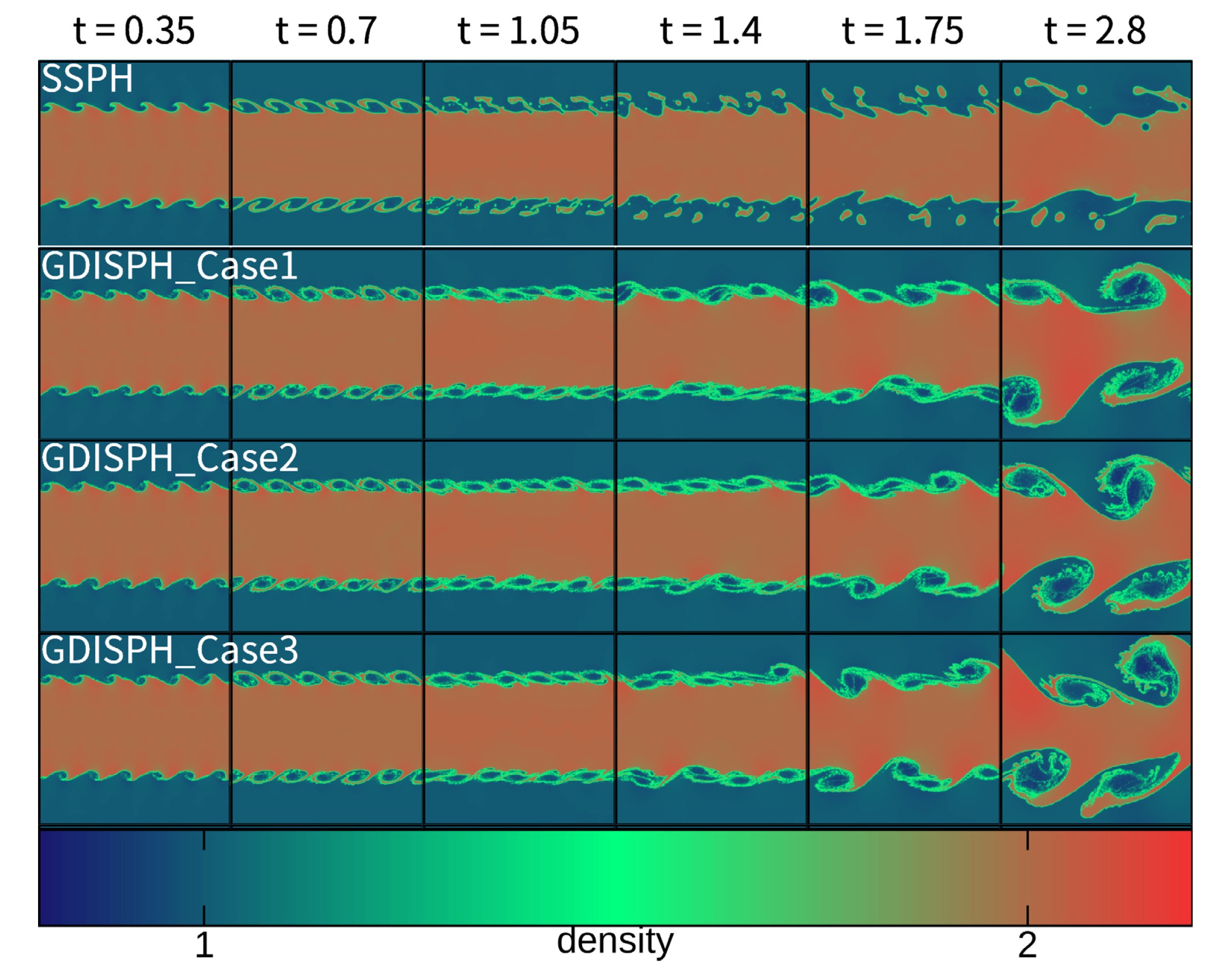
Numerical experiment of Kelvin–Helmholtz instability. Adapted from "Novel hydrodynamic schemes capturing shocks and contact discontinuities and comparison study with existing methods," Yuasa and Mori, New Astronomy, 109, 102208 (2024).
As published in Yuasa & Mori (2024), GDISPH combines Godunov-type approximate Riemann solvers with a density-independent SPH formulation (DISPH). This approach preserves the adaptive and grid-free nature of SPH while improving accuracy and stability. It accurately resolves contact discontinuities through gradient-based interpolation and high-fidelity interface handling, while also solving inter-particle forces using physically consistent Riemann solvers to suppress numerical instabilities in shock-dominated and high-density-contrast flows.
The method incorporates symmetric formulations that conserve fundamental quantities and implements zeroth- and first-order consistency corrections. By introducing physically correct flux calculations via Godunov methods, GDISPH significantly improves the resolution of shocks and contact surfaces. Benchmark tests including the Kelvin–Helmholtz instability, Rayleigh–Taylor instability, and Sedov blast wave confirm its high precision and robustness. As a foundational technique, GDISPH shows strong potential for applications across not only astrophysics but also other scientific and engineering disciplines.
We are developing advanced N-body schemes alongside a high-order Hermite integrator optimized for multi-GPU environments to maximize both performance and accuracy in gravitational N-body simulations. This code employs an O(N2) algorithm that directly computes all pairwise gravitational interactions and evaluates not only accelerations but also their derivatives (jerk), ensuring highly precise secular dynamical evolution.
The implementation leverages OpenACC, enabling CPU-based codes to be adapted for GPU execution with minimal rewriting. By employing high-speed direct node-to-node communication, the approach achieves low-latency data transfer without passing through CPUs. All computations occur on GPUs, with particle data stored entirely in GPU memory, eliminating PCIe bottlenecks.
Benchmark tests on the latest NVIDIA GPUs demonstrate nearly ideal parallel efficiency up to 64 GPUs in collisional N-body simulations with N = 107 particles. This scalability makes it practical to track the secular dynamical evolution of galaxies and star clusters within realistic computational times. Ongoing development aims to push performance even further.
We are advancing astrophysical research through the application of machine learning. In particular, supervised learning and generative models are being employed to extract unknown physical processes and to improve predictive power for future observations. Our current focus is on analyzing tidal interactions between satellite and host galaxies to uncover the properties of dark matter halos.
In Kaneda, Mori & Amagasa (2025), we propose the use of convolutional neural networks (CNNs) to estimate the density distribution of dark matter halos associated with satellite galaxies without assuming dynamical equilibrium. Using density maps derived from numerical simulations with known ground-truth profiles, we trained CNNs to classify whether tidally disrupted dark matter subhalos originated as cusp-like or core-like systems. Future work aims to integrate these models with observational data to gain deeper insight into galaxy formation and secular evolution.
By combining advanced numerical simulations with supercomputing resources, we investigate visualization techniques for massive astrophysical datasets, including gravitational N-body systems and hydrodynamics. The scope spans galaxy formation and evolution, galaxy collisions, and the dynamics of supermassive black holes and their surroundings. These phenomena extend across extreme spatial scales and involve highly complex dynamical interactions, making them challenging to study through theory and observation alone.
Our work produces high-resolution, time-resolved visualizations of N-body and hydrodynamical simulations, providing intuitive insight into large-scale spatial structures and secular dynamical changes. With massively parallel computation, we simulate billions of particles or grid points, capturing features such as tidal tails from galaxy mergers, shock waves, and gas dynamics around black holes. These visualizations not only validate theoretical models and reveal new mechanisms but also contribute to scientific outreach and education. By presenting interactive displays and immersive media in classrooms and public events, we aim to deepen understanding of astrophysics while inspiring scientific curiosity across generations.
Future directions include integrating automated feature extraction via machine learning and immersive visualization through VR/AR technologies. These efforts will broaden the impact of astrophysical visualization across research, education, and public engagement.
Building on methodologies originally developed for astrophysical research, we apply computational science approaches to the field of sports sciences. In particular, we use advanced numerical fluid dynamics techniques, such as CFD and particle-based methods, to analyze airflow and dynamical interactions around athletes and sporting equipment.
Our applied research leverages supercomputer resources and parallel computing frameworks (MPI, OpenMP, CUDA, OpenACC) to conduct large-scale numerical simulations. These high-resolution calculations reproduce realistic, dynamically evolving environments that are difficult to capture in traditional experiments, thereby providing quantitative insights into the physics of athletic motion.
Through these applications, we aim to establish a deeper scientific basis for understanding aerodynamic influences in sports and to broaden perspectives on the interaction between athletes, equipment, and their environments.